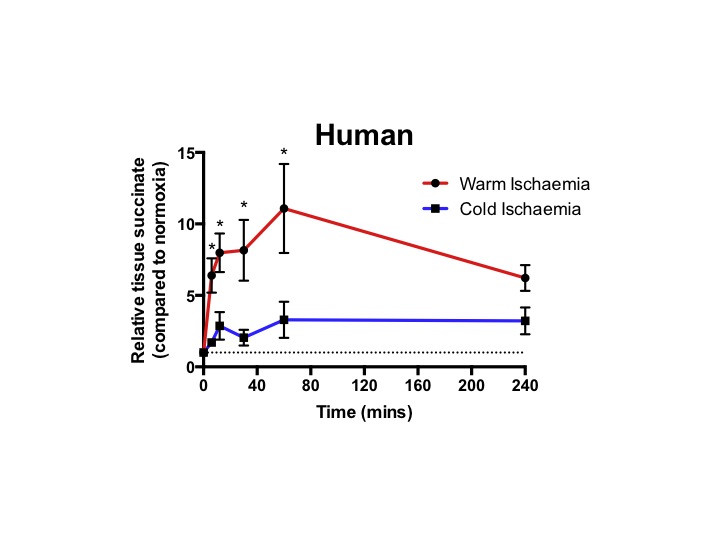Succinate Accumulation During Warm and Cold Ischemia in Mouse, Pig and Man: Mechanistic and Therapeutic Implications for Transplant Ischemia-Reperfusion Injury.
1Department of Surgery, Cambridge, United Kingdom
2MRC Cancer Unit, Cambridge, United Kingdom
3MRC Mitochondrial Biology Unit, Cambridge, United Kingdom
Meeting: 2017 American Transplant Congress
Abstract number: A168
Keywords: Ischemia
Session Information
Session Name: Poster Session A: Ischemic Injury and Organ Preservation Session I
Session Type: Poster Session
Date: Saturday, April 29, 2017
Session Time: 5:30pm-7:30pm
 Presentation Time: 5:30pm-7:30pm
Presentation Time: 5:30pm-7:30pm
Location: Hall D1
Introduction: The burst of reactive oxygen species associated with ischemia-reperfusion (IR) injury is mediated through a specific metabolic pathway involving mitochondrial accumulation of the metabolite succinate. We hypothesized that succinate accumulation during ischemia is a fundamental process shared by mouse, pig and human tissues and may underlie the greater detrimental impact of warm ischemia.
Methods: Hearts from anaesthetised mice were exposed to warm or cold ischemia (n=5-8). Pig (n=5) or human (n=4) apical heart tissue was procured immediately after exsanguination (pig) or following cross-clamp during donation after brainstem death. Tissue was rapidly divided and stored for variable periods of warm and cold ischemia. Metabolite concentrations were determined using mass spectrometry and compared to clamp-frozen normoxic controls.
Results: Metabolic changes during ischemia were similar in mice, pigs and humans (figures 1 and 2). Succinate accumulation was 2-fold higher after 12 mins of warm ischemia than 240 mins of cold ischemia (human;8.0±1.4 vs 3.2±0.9 [n=4] p=0.03, pig;5.2±0.9 vs 1.9±0.6 [n=5] p=0.02 (mean±SEM). Thus, compared to cold ischemia, warm ischemia resulted in a much greater and more rapid increase in succinate levels.
 Discussion: Greater succinate accumulation during warm ischemia may underlie worse IR injury and organ dysfunction following donation after circulatory death. Prevention of succinate accumulation using inhibitors of the enzyme succinate dehydrogenase is therefore a promising therapeutic strategy to ameliorate IR injury in organ transplantation.
Discussion: Greater succinate accumulation during warm ischemia may underlie worse IR injury and organ dysfunction following donation after circulatory death. Prevention of succinate accumulation using inhibitors of the enzyme succinate dehydrogenase is therefore a promising therapeutic strategy to ameliorate IR injury in organ transplantation.
CITATION INFORMATION: Martin J, Costa A, Gruszczyk A, Hamed M, Georgakopoulos N, Pettigrew G, James A, Frezza C, Murphy M, Saeb-Parsy K. Succinate Accumulation During Warm and Cold Ischemia in Mouse, Pig and Man: Mechanistic and Therapeutic Implications for Transplant Ischemia-Reperfusion Injury. Am J Transplant. 2017;17 (suppl 3).
To cite this abstract in AMA style:
Martin J, Costa A, Gruszczyk A, Hamed M, Georgakopoulos N, Pettigrew G, James A, Frezza C, Murphy M, Saeb-Parsy K. Succinate Accumulation During Warm and Cold Ischemia in Mouse, Pig and Man: Mechanistic and Therapeutic Implications for Transplant Ischemia-Reperfusion Injury. [abstract]. Am J Transplant. 2017; 17 (suppl 3). https://atcmeetingabstracts.com/abstract/succinate-accumulation-during-warm-and-cold-ischemia-in-mouse-pig-and-man-mechanistic-and-therapeutic-implications-for-transplant-ischemia-reperfusion-injury/. Accessed December 24, 2025.« Back to 2017 American Transplant Congress
